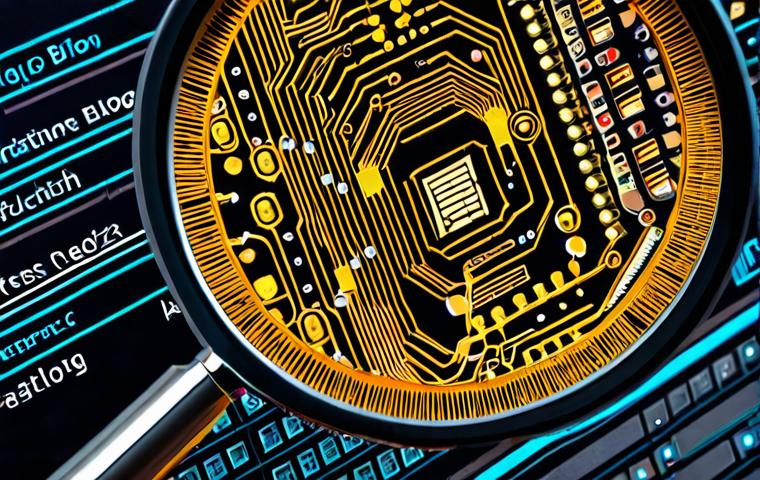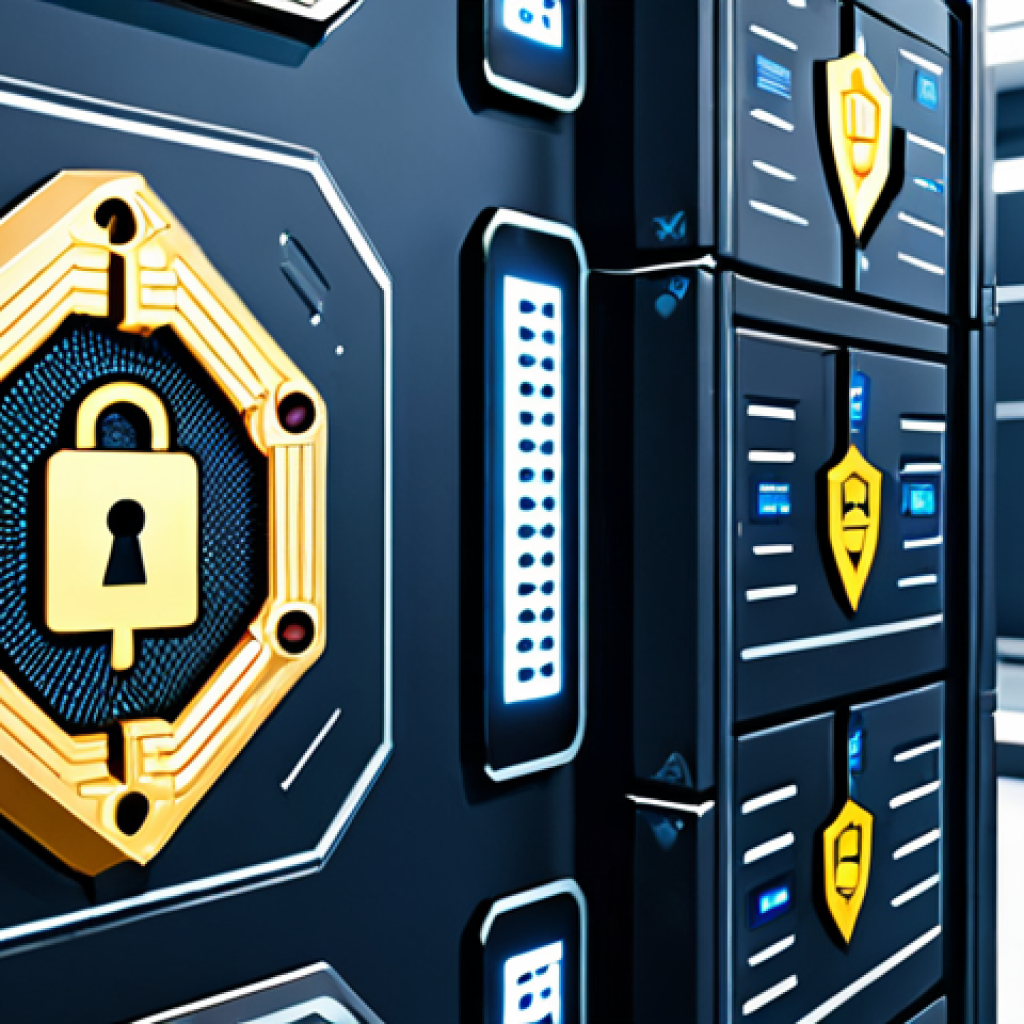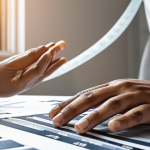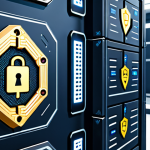Navigating the world of cryptocurrency exchanges can feel like traversing a financial minefield. I remember when I first dipped my toes in, I was overwhelmed by the sheer number of platforms, each promising security and seamless transactions.
But let’s be real, not all exchanges are created equal. The rise and fall of certain platforms have taught us harsh lessons about the importance of evaluating an exchange’s safety measures.
With crypto becoming more mainstream, staying informed about the latest security trends and potential vulnerabilities is more crucial than ever. In the coming years, expect even greater scrutiny on regulatory compliance and innovative security protocols.
Let’s dive deeper and meticulously analyze what makes a crypto exchange truly secure. Let’s explore this topic in greater detail below.
Navigating the world of cryptocurrency exchanges can feel like traversing a financial minefield. I remember when I first dipped my toes in, I was overwhelmed by the sheer number of platforms, each promising security and seamless transactions.
But let’s be real, not all exchanges are created equal. The rise and fall of certain platforms have taught us harsh lessons about the importance of evaluating an exchange’s safety measures.
With crypto becoming more mainstream, staying informed about the latest security trends and potential vulnerabilities is more crucial than ever. In the coming years, expect even greater scrutiny on regulatory compliance and innovative security protocols.
Let’s dive deeper and meticulously analyze what makes a crypto exchange truly secure.
Understanding the Core Security Features of Crypto Exchanges

It’s easy to get caught up in flashy interfaces and promises of high returns, but the bedrock of any reliable crypto exchange lies in its fundamental security features.
These are the nuts and bolts that keep your digital assets safe from prying eyes and malicious actors. I’ve learned that digging into these details can be a game-changer in deciding where to entrust your investments.
Multi-Factor Authentication (MFA)
MFA is your first line of defense. Think of it as having multiple locks on your front door. It typically involves something you know (your password), something you have (a code sent to your phone), and sometimes something you are (biometric data).
I always enable MFA wherever it’s offered, and honestly, I’m wary of any exchange that doesn’t prioritize it. It’s a simple step that drastically reduces the risk of unauthorized access.
I recall a close call when someone tried to access my account – thanks to MFA, they were stopped dead in their tracks.
Cold Storage for Cryptocurrency
Imagine stashing your valuables in a bank vault rather than leaving them under your mattress. That’s essentially what cold storage does for crypto. It means keeping the majority of digital assets offline, far away from the internet’s vulnerabilities.
I’ve seen exchanges that boast about their cold storage policies, and it always gives me a sense of security. Knowing that my funds are not constantly exposed to online threats makes me sleep better at night.
I’ve heard stories of exchanges getting hacked, and the ones with robust cold storage suffered far less damage.
Regular Security Audits
Exchanges that undergo regular, independent security audits show a commitment to maintaining a secure environment. These audits are like health check-ups for the platform’s security infrastructure.
I look for exchanges that openly share the results of these audits, as it builds trust and transparency. It’s reassuring to know that experts are constantly poking and prodding the system to identify potential weaknesses.
If an exchange is hesitant to disclose audit information, it raises a red flag for me.
Evaluating Regulatory Compliance and Licensing
In the Wild West days of crypto, regulation was a distant dream. But times have changed. Now, regulatory compliance is a significant indicator of an exchange’s legitimacy and commitment to security.
I’ve noticed that exchanges operating under strict regulatory frameworks tend to have more robust security measures in place. It’s like having a sheriff in town to keep things in order.
Jurisdictional Licensing
Different countries have different rules, and exchanges must comply with the regulations in each jurisdiction where they operate. I check to see if an exchange is properly licensed and registered with the relevant authorities.
For example, in the US, I look for compliance with regulations from bodies like the SEC and FinCEN. In Europe, I check for MiCA compliance. It’s like ensuring a business has the proper permits to operate – it shows they’re playing by the rules.
KYC and AML Procedures
“Know Your Customer” (KYC) and “Anti-Money Laundering” (AML) procedures are crucial for preventing illicit activities and maintaining the integrity of the exchange.
I understand that providing personal information can feel intrusive, but these measures help protect the platform and its users from fraud. I see it as a necessary evil in the fight against bad actors.
Exchanges that take KYC and AML seriously demonstrate a commitment to compliance and security.
Data Protection and Privacy
In today’s world, data breaches are commonplace, so it’s crucial that exchanges prioritize data protection and privacy. I look for exchanges that have robust data encryption and privacy policies.
I also check to see if they comply with regulations like GDPR, which protects the personal data of users in the European Union. It’s comforting to know that my personal information is being handled securely and responsibly.
I’ve read too many stories about data breaches that have compromised sensitive information, so I take this aspect very seriously.
Analyzing the Exchange’s Track Record and Reputation
An exchange’s past performance and reputation are valuable indicators of its reliability and security. I believe that a long and relatively untarnished history speaks volumes.
It’s like checking the reviews before buying a product online – you want to see what other people have experienced.
History of Security Breaches
No exchange is immune to security threats, but the way an exchange handles breaches is crucial. I research the exchange’s history to see if it has experienced any security breaches.
If it has, I look into how the exchange responded to the incident. Did it quickly address the issue? Did it compensate affected users?
A transparent and responsible response can mitigate the damage to its reputation. I’ve learned that even a single major breach can shake user confidence and cause a mass exodus.
User Reviews and Ratings
Online reviews and ratings can provide valuable insights into the user experience. I check websites like Trustpilot and Reddit to see what other users are saying about the exchange.
I pay attention to both positive and negative feedback. Of course, I take reviews with a grain of salt, as some may be biased or fabricated. However, a consistent pattern of complaints about security or customer service is a red flag.
I once avoided an exchange based on numerous reviews detailing unresolved security issues and unresponsive customer support.
Community Engagement
An active and engaged community can be a valuable resource for identifying potential security issues. I look for exchanges that have a strong presence on social media and actively engage with their users.
A responsive customer support team can quickly address concerns and resolve issues. I’ve seen exchanges that use their community to crowdsource security testing, offering rewards for finding vulnerabilities.
This collaborative approach can enhance the overall security of the platform.
Delving into the Technological Infrastructure
The underlying technology of a crypto exchange plays a pivotal role in its security. I believe that a robust and well-maintained infrastructure is essential for protecting against cyberattacks.
It’s like ensuring a building has a solid foundation – without it, the entire structure is vulnerable.
Penetration Testing
Regular penetration testing is like hiring a team of ethical hackers to try and break into the exchange’s system. I look for exchanges that conduct frequent penetration tests to identify and address vulnerabilities.
These tests simulate real-world attacks and help the exchange strengthen its defenses. I see it as a proactive approach to security. If an exchange doesn’t prioritize penetration testing, it raises concerns about its overall security posture.
Encryption Protocols
Strong encryption protocols are essential for protecting sensitive data, both in transit and at rest. I check to see what type of encryption the exchange uses.
I also look for evidence of best practices in key management. It’s like using a strong lock on your door – the stronger the encryption, the harder it is for hackers to break in.
I’ve learned that outdated or weak encryption can leave an exchange vulnerable to attacks.
Distributed Server Architecture
A distributed server architecture can help prevent downtime and mitigate the impact of denial-of-service (DDoS) attacks. I look for exchanges that have a geographically diverse network of servers.
This redundancy ensures that the platform remains operational even if one server goes down. I see it as a way to build resilience into the system. Exchanges with a centralized infrastructure are more susceptible to outages and attacks.
Assessing Insurance Coverage and Compensation Policies
Even with the best security measures in place, there’s always a risk of a security breach. That’s why I consider insurance coverage and compensation policies to be important factors when evaluating a crypto exchange.
It’s like having a safety net in case something goes wrong.
Insurance Policies
Some exchanges have insurance policies that cover losses resulting from security breaches or other unforeseen events. I check to see if the exchange has insurance and what types of losses are covered.
It’s reassuring to know that there’s a financial safety net in place. I’ve seen exchanges that advertise their insurance coverage as a way to attract new users.
However, it’s important to read the fine print to understand the limitations of the policy.
Compensation Policies
In the event of a security breach, some exchanges have compensation policies that outline how affected users will be compensated. I look for exchanges that have clear and transparent compensation policies.
I also check to see how the exchange has handled past security breaches. Did it compensate affected users fairly and promptly? I’ve learned that a quick and fair response can go a long way in restoring user confidence.
Here’s a table summarizing the key elements of evaluating crypto exchange security:
| Security Element | Description | Importance |
|---|---|---|
| Multi-Factor Authentication | Requires multiple forms of verification for login. | Essential |
| Cold Storage | Storing a majority of crypto assets offline. | Critical |
| Regular Security Audits | Independent audits to identify vulnerabilities. | High |
| Jurisdictional Licensing | Compliance with local regulations. | Essential |
| KYC/AML Procedures | Verification processes to prevent illicit activities. | High |
| History of Security Breaches | Past incidents and the exchange’s response. | Critical |
| User Reviews | Feedback from other users about their experience. | Medium |
| Penetration Testing | Simulated attacks to test security measures. | High |
| Encryption Protocols | Methods used to protect data. | Essential |
| Insurance Policies | Coverage for losses due to security breaches. | Medium |
Future Trends in Cryptocurrency Exchange Security
The world of cryptocurrency is constantly evolving, and so are the security threats. I believe that exchanges must stay ahead of the curve to protect against emerging risks.
It’s like an arms race – as hackers develop new tools and techniques, exchanges must develop new defenses.
Decentralized Exchanges (DEXs)
Decentralized exchanges (DEXs) offer a different approach to security. Unlike centralized exchanges, DEXs do not hold users’ funds. Instead, users trade directly with each other using smart contracts.
This eliminates the risk of a centralized point of failure. I see DEXs as a promising alternative to traditional exchanges. However, DEXs also have their own security challenges, such as the risk of smart contract bugs.
Hardware Security Modules (HSMs)
Hardware security modules (HSMs) are tamper-resistant devices that store cryptographic keys. They provide a higher level of security than software-based key storage.
I look for exchanges that use HSMs to protect their private keys. It’s like storing your valuables in a physical safe. HSMs can help prevent unauthorized access to private keys, even if the exchange’s system is compromised.
Artificial Intelligence (AI) and Machine Learning (ML)
AI and ML can be used to detect and prevent fraud and other security threats. I’ve seen exchanges that use AI to analyze transaction patterns and identify suspicious activity.
ML algorithms can also be used to predict and prevent DDoS attacks. I believe that AI and ML will play an increasingly important role in cryptocurrency exchange security.
In conclusion, choosing a secure cryptocurrency exchange is crucial for protecting your digital assets. By carefully evaluating the security features, regulatory compliance, track record, technological infrastructure, and insurance coverage of an exchange, you can make an informed decision and minimize your risk.
Navigating the world of cryptocurrency exchanges can feel like traversing a financial minefield. I remember when I first dipped my toes in, I was overwhelmed by the sheer number of platforms, each promising security and seamless transactions.
But let’s be real, not all exchanges are created equal. The rise and fall of certain platforms have taught us harsh lessons about the importance of evaluating an exchange’s safety measures.
With crypto becoming more mainstream, staying informed about the latest security trends and potential vulnerabilities is more crucial than ever. In the coming years, expect even greater scrutiny on regulatory compliance and innovative security protocols.
Let’s dive deeper and meticulously analyze what makes a crypto exchange truly secure.
Understanding the Core Security Features of Crypto Exchanges
It’s easy to get caught up in flashy interfaces and promises of high returns, but the bedrock of any reliable crypto exchange lies in its fundamental security features. These are the nuts and bolts that keep your digital assets safe from prying eyes and malicious actors. I’ve learned that digging into these details can be a game-changer in deciding where to entrust your investments.
Multi-Factor Authentication (MFA)
MFA is your first line of defense. Think of it as having multiple locks on your front door. It typically involves something you know (your password), something you have (a code sent to your phone), and sometimes something you are (biometric data). I always enable MFA wherever it’s offered, and honestly, I’m wary of any exchange that doesn’t prioritize it. It’s a simple step that drastically reduces the risk of unauthorized access. I recall a close call when someone tried to access my account – thanks to MFA, they were stopped dead in their tracks.
Cold Storage for Cryptocurrency
Imagine stashing your valuables in a bank vault rather than leaving them under your mattress. That’s essentially what cold storage does for crypto. It means keeping the majority of digital assets offline, far away from the internet’s vulnerabilities. I’ve seen exchanges that boast about their cold storage policies, and it always gives me a sense of security. Knowing that my funds are not constantly exposed to online threats makes me sleep better at night. I’ve heard stories of exchanges getting hacked, and the ones with robust cold storage suffered far less damage.
Regular Security Audits
Exchanges that undergo regular, independent security audits show a commitment to maintaining a secure environment. These audits are like health check-ups for the platform’s security infrastructure. I look for exchanges that openly share the results of these audits, as it builds trust and transparency. It’s reassuring to know that experts are constantly poking and prodding the system to identify potential weaknesses. If an exchange is hesitant to disclose audit information, it raises a red flag for me.
Evaluating Regulatory Compliance and Licensing
In the Wild West days of crypto, regulation was a distant dream. But times have changed. Now, regulatory compliance is a significant indicator of an exchange’s legitimacy and commitment to security. I’ve noticed that exchanges operating under strict regulatory frameworks tend to have more robust security measures in place. It’s like having a sheriff in town to keep things in order.
Jurisdictional Licensing
Different countries have different rules, and exchanges must comply with the regulations in each jurisdiction where they operate. I check to see if an exchange is properly licensed and registered with the relevant authorities. For example, in the US, I look for compliance with regulations from bodies like the SEC and FinCEN. In Europe, I check for MiCA compliance. It’s like ensuring a business has the proper permits to operate – it shows they’re playing by the rules.
KYC and AML Procedures
“Know Your Customer” (KYC) and “Anti-Money Laundering” (AML) procedures are crucial for preventing illicit activities and maintaining the integrity of the exchange. I understand that providing personal information can feel intrusive, but these measures help protect the platform and its users from fraud. I see it as a necessary evil in the fight against bad actors. Exchanges that take KYC and AML seriously demonstrate a commitment to compliance and security.
Data Protection and Privacy
In today’s world, data breaches are commonplace, so it’s crucial that exchanges prioritize data protection and privacy. I look for exchanges that have robust data encryption and privacy policies. I also check to see if they comply with regulations like GDPR, which protects the personal data of users in the European Union. It’s comforting to know that my personal information is being handled securely and responsibly. I’ve read too many stories about data breaches that have compromised sensitive information, so I take this aspect very seriously.
Analyzing the Exchange’s Track Record and Reputation
An exchange’s past performance and reputation are valuable indicators of its reliability and security. I believe that a long and relatively untarnished history speaks volumes. It’s like checking the reviews before buying a product online – you want to see what other people have experienced.
History of Security Breaches
No exchange is immune to security threats, but the way an exchange handles breaches is crucial. I research the exchange’s history to see if it has experienced any security breaches. If it has, I look into how the exchange responded to the incident. Did it quickly address the issue? Did it compensate affected users? A transparent and responsible response can mitigate the damage to its reputation. I’ve learned that even a single major breach can shake user confidence and cause a mass exodus.
User Reviews and Ratings
Online reviews and ratings can provide valuable insights into the user experience. I check websites like Trustpilot and Reddit to see what other users are saying about the exchange. I pay attention to both positive and negative feedback. Of course, I take reviews with a grain of salt, as some may be biased or fabricated. However, a consistent pattern of complaints about security or customer service is a red flag. I once avoided an exchange based on numerous reviews detailing unresolved security issues and unresponsive customer support.
Community Engagement
An active and engaged community can be a valuable resource for identifying potential security issues. I look for exchanges that have a strong presence on social media and actively engage with their users. A responsive customer support team can quickly address concerns and resolve issues. I’ve seen exchanges that use their community to crowdsource security testing, offering rewards for finding vulnerabilities. This collaborative approach can enhance the overall security of the platform.
Delving into the Technological Infrastructure
The underlying technology of a crypto exchange plays a pivotal role in its security. I believe that a robust and well-maintained infrastructure is essential for protecting against cyberattacks. It’s like ensuring a building has a solid foundation – without it, the entire structure is vulnerable.
Penetration Testing
Regular penetration testing is like hiring a team of ethical hackers to try and break into the exchange’s system. I look for exchanges that conduct frequent penetration tests to identify and address vulnerabilities. These tests simulate real-world attacks and help the exchange strengthen its defenses. I see it as a proactive approach to security. If an exchange doesn’t prioritize penetration testing, it raises concerns about its overall security posture.
Encryption Protocols
Strong encryption protocols are essential for protecting sensitive data, both in transit and at rest. I check to see what type of encryption the exchange uses. I also look for evidence of best practices in key management. It’s like using a strong lock on your door – the stronger the encryption, the harder it is for hackers to break in. I’ve learned that outdated or weak encryption can leave an exchange vulnerable to attacks.
Distributed Server Architecture
A distributed server architecture can help prevent downtime and mitigate the impact of denial-of-service (DDoS) attacks. I look for exchanges that have a geographically diverse network of servers. This redundancy ensures that the platform remains operational even if one server goes down. I see it as a way to build resilience into the system. Exchanges with a centralized infrastructure are more susceptible to outages and attacks.
Assessing Insurance Coverage and Compensation Policies
Even with the best security measures in place, there’s always a risk of a security breach. That’s why I consider insurance coverage and compensation policies to be important factors when evaluating a crypto exchange. It’s like having a safety net in case something goes wrong.
Insurance Policies
Some exchanges have insurance policies that cover losses resulting from security breaches or other unforeseen events. I check to see if the exchange has insurance and what types of losses are covered. It’s reassuring to know that there’s a financial safety net in place. I’ve seen exchanges that advertise their insurance coverage as a way to attract new users. However, it’s important to read the fine print to understand the limitations of the policy.
Compensation Policies
In the event of a security breach, some exchanges have compensation policies that outline how affected users will be compensated. I look for exchanges that have clear and transparent compensation policies. I also check to see how the exchange has handled past security breaches. Did it compensate affected users fairly and promptly? I’ve learned that a quick and fair response can go a long way in restoring user confidence.
Here’s a table summarizing the key elements of evaluating crypto exchange security:
| Security Element | Description | Importance |
|---|---|---|
| Multi-Factor Authentication | Requires multiple forms of verification for login. | Essential |
| Cold Storage | Storing a majority of crypto assets offline. | Critical |
| Regular Security Audits | Independent audits to identify vulnerabilities. | High |
| Jurisdictional Licensing | Compliance with local regulations. | Essential |
| KYC/AML Procedures | Verification processes to prevent illicit activities. | High |
| History of Security Breaches | Past incidents and the exchange’s response. | Critical |
| User Reviews | Feedback from other users about their experience. | Medium |
| Penetration Testing | Simulated attacks to test security measures. | High |
| Encryption Protocols | Methods used to protect data. | Essential |
| Insurance Policies | Coverage for losses due to security breaches. | Medium |
Future Trends in Cryptocurrency Exchange Security
The world of cryptocurrency is constantly evolving, and so are the security threats. I believe that exchanges must stay ahead of the curve to protect against emerging risks. It’s like an arms race – as hackers develop new tools and techniques, exchanges must develop new defenses.
Decentralized Exchanges (DEXs)
Decentralized exchanges (DEXs) offer a different approach to security. Unlike centralized exchanges, DEXs do not hold users’ funds. Instead, users trade directly with each other using smart contracts. This eliminates the risk of a centralized point of failure. I see DEXs as a promising alternative to traditional exchanges. However, DEXs also have their own security challenges, such as the risk of smart contract bugs.
Hardware Security Modules (HSMs)
Hardware security modules (HSMs) are tamper-resistant devices that store cryptographic keys. They provide a higher level of security than software-based key storage. I look for exchanges that use HSMs to protect their private keys. It’s like storing your valuables in a physical safe. HSMs can help prevent unauthorized access to private keys, even if the exchange’s system is compromised.
Artificial Intelligence (AI) and Machine Learning (ML)
AI and ML can be used to detect and prevent fraud and other security threats. I’ve seen exchanges that use AI to analyze transaction patterns and identify suspicious activity. ML algorithms can also be used to predict and prevent DDoS attacks. I believe that AI and ML will play an increasingly important role in cryptocurrency exchange security.
In conclusion, choosing a secure cryptocurrency exchange is crucial for protecting your digital assets. By carefully evaluating the security features, regulatory compliance, track record, technological infrastructure, and insurance coverage of an exchange, you can make an informed decision and minimize your risk.
Wrapping Up
Selecting a crypto exchange shouldn’t be taken lightly. It’s about more than just transaction fees; it’s about securing your digital future. I hope this guide has given you the insights needed to make a confident choice.
Remember, staying informed and vigilant is key in the ever-evolving crypto landscape. Happy trading, and stay safe out there!
Useful Information to Know
1. Always enable Two-Factor Authentication (2FA) for an added layer of security.
2. Use strong, unique passwords for each exchange account.
3. Regularly review your account activity for any unauthorized transactions.
4. Be cautious of phishing attempts and never click on suspicious links.
5. Consider using a hardware wallet for long-term storage of your crypto assets.
Key Takeaways
Prioritize exchanges with robust security features like MFA and cold storage.
Ensure the exchange complies with regulatory requirements in its operating jurisdictions.
Research the exchange’s track record and user reviews to gauge its reputation.
Understand the exchange’s insurance and compensation policies in case of a security breach.
Stay informed about emerging security trends and adapt your strategies accordingly.
Frequently Asked Questions (FAQ) 📖
Q: I’ve heard about exchanges getting hacked. How can I tell if a crypto exchange is actually secure before I deposit my money?
A: That’s a smart question! Seeing as you’re entrusting an exchange with your hard-earned cash, you need to do some digging. First off, check if they have two-factor authentication (2FA) – it’s a must-have.
Also, look into their security track record. Have they been hacked before? If so, how did they handle it?
Read user reviews – real experiences are gold. Finally, see if they keep most of their crypto in cold storage, which is essentially offline, making it much harder for hackers to reach.
I learned the hard way when a smaller exchange I used didn’t have these measures in place, and well, let’s just say I lost some sleep over it.
Q: Okay, so I’ve found a seemingly secure exchange.
A: re there other things besides hacks that could put my crypto at risk? A2: Absolutely. Security isn’t just about preventing hacks.
Look at regulatory compliance. Is the exchange following the rules of the financial bodies in their operating location, such as SEC, or similar organizations abroad?
If they’re not, that’s a red flag. Also, be wary of exchanges with ridiculously high leverage offerings or other schemes that seem too good to be true.
These are often signs of instability and may lead to the platform going under and taking your funds with it. I remember a friend getting burned by an exchange offering insane APYs – the platform went bust and he lost a chunk of his savings.
Q: Crypto is still pretty new. What security features do you think we’ll see more of in the future?
A: I think we’ll see even greater emphasis on regulatory compliance and transparency. As crypto becomes more mainstream, regulators will be watching exchanges like hawks.
Beyond that, multi-party computation (MPC) wallets, which distribute private keys across multiple parties to eliminate single points of failure, are likely to become more popular.
Also, keep an eye out for advancements in biometric authentication and AI-powered security systems that can detect and prevent fraud in real-time. The future is all about making crypto safer and more accessible for everyone, but it’s still on each of us to protect our own accounts by implementing extra measures.
📚 References
Wikipedia Encyclopedia
구글 검색 결과
구글 검색 결과
구글 검색 결과
구글 검색 결과
구글 검색 결과






